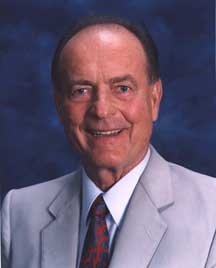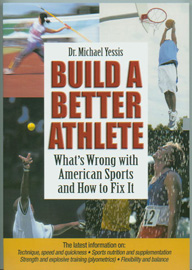The inception of the Central Virginia Sport Performance Seminar has granted me the great fortune of meeting some of the brightest minds in the

field of physical preparation. One of those individuals is Dr. Michael Yessis. Doc has truly opened my eyes and changed my worldview of the physical preparation of athletes. Today, I’d like to share with you some of those innovations:
1) You need to slow down and take a look at the exercises you’re using.
If you cannot find a direct correlation between the training means and the skill implemented in competition, then you probably shouldn’t be using that exercise. Before you blow this off, slow down with your judgments and take a look at your programming. Is there some exercises you do because “so and so said so” or “because it’s a great strength exercise”? If those are your reasons, and you can’t connect them DIRECTLY to a skill or part of a skill in a sport, then maybe there really isn’t a reason to implement that exercise. Now, there are something’s that I implement that don’t have a “direct carry over” like planks (the exercise, not the pictures), antagonist exercises (although some choices are better than others in my opinion) and some “warm up” exercises. Take a look at your programming and question all of it. It might be an eye opening experience to you, and a great day for your athletes in their training.
2) Specialized exercises are NOT functional training.

As a matter of fact, I think that specialized exercises are what became bastardized by the “functional crowd” by adding balls and discs and all the other “toys”. Specialized exercises, in a nut shell, are exercises that have a direct carry over to a technique, or part of a technique, in sport. At this point, the specialized exercises that I’ve implemented regularly have been focused on running (both sprinting and starting/accelerating) in the form of the knee drive, paw back and lunges (both linear and lateral). I know without a shadow of a doubt that since we implemented these movements, the athlete’s I work with move better, are quicker and are faster. They’re not just some “cute” exercise with bands; it’s a movement where you are working to better your technique in a skill, and doing so properly will improve performance.
3) Technique is the most important factor to performance.
Now, before you jump up and down with your “well, that’s why we have sport coaches” rant, let me say this. If I do anything to screw with one

of my guy’s jump shot, or a swimmer’s stroke in the water, then I’d be playing with fire when it comes to my job, so I’m not necessarily talking about those techniques. Although I do believe Doc when he says that there are exercises that will improve parts of these skills, i.e. shooting range and improving the quickness of the release in a shot, honestly I don’t have the stones to dive into that aspect yet. What I am referring to are running mechanics, cutting, jumping, and stopping. Basically I’m talking about general movements that are important in team sports. Now, this obviously ties in with the special exercises, but it’s really just about looking at the movement performed, breaking it down from the beginning, and starting over. Teach it slow, work to increase your speed as the technique improves, and you’ll see real results with how your athletes move.
4) People don’t put enough emphasis on general strength training.
Yes, Doc has taught me this. People need to be stronger, period. Now, there is a specific way that he feels it should be done, and when following his protocols and/or variations thereof, we have seen tremendous improvements in strength. The strength that is needed to move into more advanced training needs to be developed so that special strength training can have a foundation to build upon. People think Doc is all about special exercises and plyometrics, and while he’s a big advocate of those, there are requirements that need to be met prior to implementing these, which are reached by proper general strength training.
5) People put too much of an emphasis on general strength training.
I know, I know, I just said the exact opposite. Here’s the kicker though. We as performance coaches put too much emphasis on volume and intensity. Again it comes back to the idea of right place, right time. If I took these points and classified them as to which was the most important point I took from Doc, it would be this one. Use as low of an intensity as possible with as little volume as possible needed to yield a stimulus that brings about improvement. Then increase it just a little. These small increases over a longer duration of time allow for a greater ability to maintain the improvements throughout the season, and an easier measure to determine where the athletes are in their level or preparedness/readiness, meaning you’ll know where changes in the programming need to occur. It comes down to the proper stimulus at the correct time in the right quantity at the needed intensity. No more, no less.
These five points have truly brought great improvements to the performance of my athletes in the competitive activities they are involved in, and I owe it all to Doc’s guidance and friendship helping me along the way. I hope that this advice helps our readers, and makes them take a step back and look at the what’s and why’s they’re using the means, volumes and intensities they implement with their athletes, and see if there is a more efficient way of bringing around at least the same, if not better results.
Enjoy the content? Then you should check out The Strength Coach Network!
You can find sensational content just like this in The Strength Coach Network. As a member of The Strength Coach Networks, you can access over 200 hours of the highest-level lecture content just like this one for 48 hours for only $1. Follow the link below to sign up and use the code CVASPS at check out to get a 48 hour trial for only $1. Check out The Strength Coach Network Here! https://strengthcoachnetwork.com/cvasps/
#StrengthCoach, #StrengthAndConditioningCoach, #Podcast, #LearningAtLunch, #TheSeminar, #SportsTraining, #PhysicalPreparation, #TheManual, #SportTraining, #SportPerformance, #HumanPerformance, #StrengthTraining, #SpeedTraining, #Training, #Coach, #Performance, #Sport, #HighPerformance, #VBT, #VelocityBasedTraining, #TriphasicTraining, #Plyometrics

